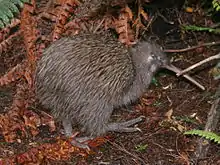Buff-banded rail
The buff-banded rail (Hypotaenidia philippensis) is a distinctively coloured, highly dispersive, medium-sized rail of the rail family, Rallidae. This species comprises several subspecies found throughout much of Australasia and the south-west Pacific region, including the Philippines (where it is known as tikling), New Guinea, Australia (where it is known as a Misery chicken), New Zealand (where it is known as the banded rail or moho-pererū in Māori),[2] and numerous smaller islands, covering a range of latitudes from the tropics to the Subantarctic.
| Buff-banded rail | |
|---|---|
 | |
| Scientific classification | |
| Kingdom: | Animalia |
| Phylum: | Chordata |
| Class: | Aves |
| Order: | Gruiformes |
| Family: | Rallidae |
| Genus: | Hypotaenidia |
| Species: | H. philippensis |
| Binomial name | |
| Hypotaenidia philippensis (Linnaeus, 1766) | |
| Synonyms | |
| |
Description
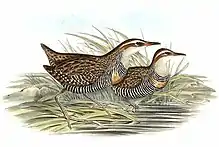
It is a largely terrestrial bird the size of a small domestic chicken, with mainly brown upperparts, finely banded black and white underparts, a white eyebrow, chestnut band running from the bill round the nape, with a buff band on the breast. It utilises a range of moist or wetland habitats with low, dense vegetation for cover. It is usually quite shy but may become very tame and bold in some circumstances, such as in island resorts within the Great Barrier Reef region.[3]
The buff-banded rail is an omnivorous scavenger which feeds on a range of terrestrial invertebrates and small vertebrates, seeds, fallen fruit and other vegetable matter, as well as carrion and refuse. Its nest is usually situated in dense grassy or reedy vegetation close to water, with a clutch size of 3–4. Although some island populations may be threatened, or even exterminated, by introduced predators, the species as a whole appears to be safe and its conservation status is considered to be of Least Concern.[4]
Evolution
Numerous subspecies are recognised for the buff-banded rail because of repeated dispersion of birds to islands in the Pacific, often followed by founder effects and reduced potential for gene flow.[5] The weka in New Zealand evolved from a lineage with common ancestry to modern buff-tailed banded rail populations, and has changed over time to become flightless.
Subspecies
Described subspecies include:[6][7][8]
- H. p. admiralitatis (Stresemann, 1929), Admiralty Islands
- H. p. anachoretae (Mayr, 1949), Anchorite Islands, PNG
- H. p. andrewsi (Mathews, 1911), Cocos buff-banded rail, endemic to the Cocos (Keeling) Islands, endangered
- H. p. assimilis (G. R. Gray, 1843), New Zealand
- H. p. chlandleri, northern Sulawesi
- H. p. christophori (Mayr, 1938), Solomon Islands
- H. p. ecaudatus (J. F. Miller, 1783), (SW Pacific)
- H. p. goodsoni (Mathews, 1911), Samoa and Niue Islands
- H. p. lacustris (Mayr, 1938), (New Guinea)
- H. p. lesouefi (Mathews, 1911), New Hanover, Tabar and Tanga Islands, possibly New Ireland
- H. p. macquariensis (Hutton, 1879), Macquarie Island rail, endemic to Macquarie Island, extinct
- H. p. mellori (Mathews, 1912), Tasmania and mainland Australia
- H. p. meyeri (Hartert, 1930), Witu Island, PNG
- H. p. pelewensis (Mayr, 1933), Palau
- H. p. philippensis (Linnaeus, 1766), Philippines, Sulawesi, Buru and Sunda Islands
- H. p. praedo (Mayr, 1949), Skoki Island, Admiralty Islands
- H. p. randi (Mayr & Gilliard, 1951)
- H. p. reductus (Mayr, 1938), northern New Guinea
- H. p. sethsmithi (Mathews, 1911), Vanuatu, Fiji
- H. p. swindellsi (Mathews, 1911), New Caledonia and Loyalty Islands
- H. p. tounelieri Schodde & Naurois, 1982, Coral Sea Islands
- H. p. wahgiensis (Mayr & Gilliard, 1951), central highlands of New Guinea
- H. p. wilkinsoni (Mathews, 1911), Flores
- H. p. xerophilus (Bemmel & Hoogerwerf, 1940), (Indonesia)
- H. p. yorki, Moluccas, western and southern New Guinea
Gallery and media
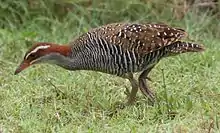 Buff-banded rail, G. philippensis, Fafa island, Tonga
Buff-banded rail, G. philippensis, Fafa island, Tonga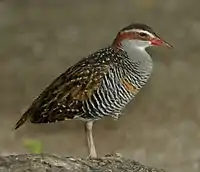 East Australian race G. p. mellori
East Australian race G. p. mellori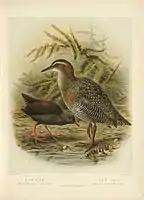 Extinct Caroline Islands rail Porzana monasa, left, with G. philippensis
Extinct Caroline Islands rail Porzana monasa, left, with G. philippensis.jpg.webp) Buff-banded rail at Green Island National Park, Green Island, Queensland, Australia
Buff-banded rail at Green Island National Park, Green Island, Queensland, Australia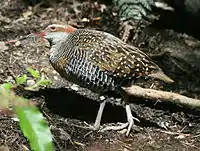
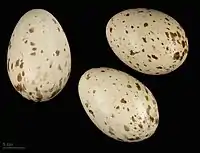 Gallirallus philippensis - MHNT
Gallirallus philippensis - MHNT
See also
 Birds portal
Birds portal New Zealand portal
New Zealand portal Oceania portal
Oceania portal
References
- BirdLife International (2016). "Hypotaenidia philippensis". IUCN Red List of Threatened Species. 2016. doi:10.2305/IUCN.UK.2012-1.RLTS.T22692425A38360502.en.
- Hugh Robertson, Barrie Heather (Author), & Derek Onley. (2005) The Field Guide to the Birds of New Zealand Revised edition, Viking.
- Marchant, S.; & Higgins, P.J. (Eds). (1993). Handbook of Australian, New Zealand and Antarctic Birds. Volume 2: Raptors to Lapwings. Oxford University Press: Melbourne. ISBN 0-19-553069-1
- BirdLife International. (2006). Species factsheet: Gallirallus philippensis. Downloaded "Archived copy". Archived from the original on 10 July 2007. Retrieved 2012-12-10.CS1 maint: archived copy as title (link) on 25 October 2006
- Garcia-R., Juan C.; Joseph, Leo; Adcock, Greg; Reid, Julian; Trewick, Steven A. (2017). "Interisland gene flow among populations of the buff-banded rail(Aves: Rallidae) and its implications for insular endemism in Oceania". Journal of Avian Biology. 48: 679–690. doi:10.1111/jav.01201.
- Pied-billed Grebe (Porphyrio podiceps)
- Coates, Brian J. (1985). The Birds of Papua New Guinea. Volume 1: Non-Passerines. Dove Publications: Alderley, Queensland. ISBN 0-9590257-0-7
- Zoonomen - Zoological Nomenclature Resource, 2006.07.04
External links
 Media related to Gallirallus philippensis at Wikimedia Commons
Media related to Gallirallus philippensis at Wikimedia Commons Data related to Gallirallus philippensis at Wikispecies
Data related to Gallirallus philippensis at Wikispecies

